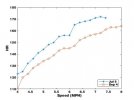Antti
Level 10 Valued Member
This post may come across as argumentative, but it really is not my intention. We are all free to make choices, but there is too much evidence both anecdotal and researched that supports a strong aerobic base.
The WHO recommendation regarding aerobic work that you are citing is the bare minimum the evidence suggests will keep an individual from dying of heart disease or another related illness. It is not the quantity that maximizes health, but is a minimum effective dose to hopefully not die.
I have read the journals, but am not going to dig out the references. The literature is out there if you choose to pursue it.
LSS cardio makes the body far more metabolically efficient. It does this in ways strength training does not. A strong aerobic base also leads to much quicker recovery times between bursts of energy, which directly affects strength training in a positive way.
As for base building. It is base building for every activity that one would want to engage in, which is different for different folks, some need a larger base than others. As @offwidth said, no amount of KB swinging or snatching in the world is going to get you the base you need for mountaineering and the WHO recommendations would build an aerobic base that would allow you to possibly climb a small hill without dying.
Here is a very direct application of base building: I am about to embark on a 10 day expedition in the Brooks Range of Alaska. We will cover anywhere from 30-50 miles on foot gaining a total of about 15-20 thousand feet of elevation. All this with a pack that will weigh between 50-75lbs. This would not even remotely be possible if a LARGE aerobic base were not present.
Your above statement really articulates your position. You do not like cardio, totally fine, it's your choice. However, that does not negate the massive health benefits of LSS.
Aerobic base building definitely is a game changer in both performance and health, but as you stated you feel there is nothing in it for you, again choices. I can say though that I have trained and operated with some very strong individuals who got gassed quickly when expected to operate in an LSS fashion for any period of time and they were a LIABILITY not a help. Look at the world' s strongest men, they are strong, but are only good for short bursts of power over very short distances and most if not all would meet the WHO recommendations for activity.
@Antti It sounds like you're ignoring the science because, as you conceded, you simply don't like cardio. ?
That's fair enough. But Pavel's 15 year old statement was really just a throwaway line, a bit of a colourful marketing statement, and is being taken out of context. His views have changed, hence, Strong Endurance.
Here's an accessible example:
Within the first 30 seconds he says, "the best, healthiest way to develop your cardio is through steady state aerobic activity, running in particular". He then explains basically MAF running. And later, explains how the mitochondria benefits from this aerobic actively benefit your strength training and allow you to replenish your strength and power. This is in line with the science.
There's a vast scientific literature showing that having a developed aerobic system allows us to survive better and live a longer life, and, importantly, to better absorb and recover from our strength training.
That's why so many StrongFirst practitioners/articles recommend MAF as a way to improve S&S, A+A, and Q&D practice on off days. Strong Endurance, all of Al Ciampas work, and the recent Nocavaine article are just a few examples.
Re the WHO guidelines, all they do is merely recommend minimum standards for not dying.... they're not about improving performance, let alone oriented to optimal performance, in short, strength, endurance or otherwise.
That said, they still don't align with what you're saying at all, lol. They support Pavel's actual view about the importance of steady state aerobic training. Copy posted from the actual guidelines:
"1. Adults aged 18–64 should do at least 150 minutes of moderate-intensity aerobic physical activity throughout the week or do at least 75 minutes of vigorous-intensity aerobic physical activity throughout the week or an equivalent combination of moderate- and vigorous-intensity activity.
2. Aerobic activity should be performed in bouts of at least 10 minutes duration.
3. For additional health benefits, adults should increase their moderate-intensity aerobic physical activity to 300 minutes per week, or engage in 150 minutes of vigorous-intensity aerobic physical activity per week, or an equivalent combination of moderate- and vigorous-intensity activity.
4. Muscle-strengthening activities should be done involving major muscle groups on 2 or more days per week"
My personal preferences must influence my views, yes.
I don't think the WHO recommendations are as pitiful as you seem to see them.
Sure, more is better health/longevity wise, but the effects diminish as we pile on more hours. Like we discussed with @Ryan T , health and longevity is also a multifaceted issue. Is an hour of aerobic exercise better than an hour of sleep? Better than an hour spent with family? Better than an hour of shopping and cooking? Better than an hour of meditation? Better than an hour of strength training? Etc. It does not exist in a vacuum.
Even so, personally, I don't see the need for extra aerobic exercise if work, chores and strength training already give me what the peer reviewed science tells me. Like I said, I easily get more than double the WHO guidelines just from training. Other activities on top of that. How would more aerobic training enhance my health and longevity, considering that time spent in it is always an opportunity cost, and there are many, many variables to invest in for health and longevity?

